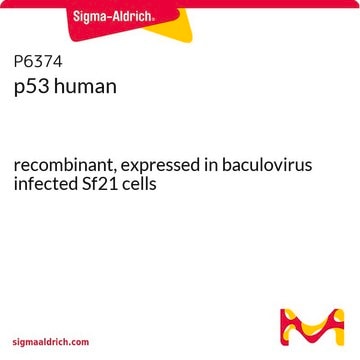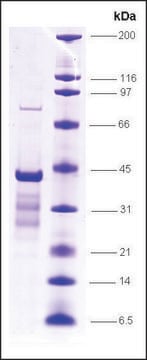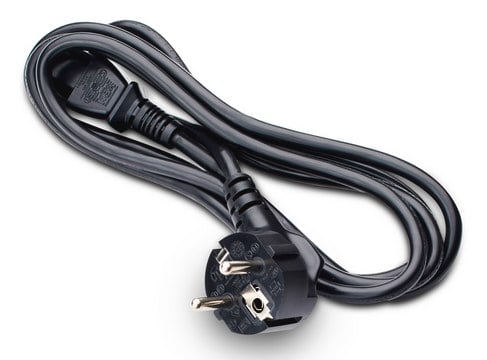SRP2108
p53 (1-81), mutant, GST tagged human
recombinant, expressed in E. coli, ≥80% (SDS-PAGE)
Sinónimos:
FLJ92943, LFS1, P53, TRP53
Iniciar sesiónpara Ver la Fijación de precios por contrato y de la organización
About This Item
Código UNSPSC:
12352200
NACRES:
NA.26
Productos recomendados
origen biológico
human
recombinante
expressed in E. coli
Análisis
≥80% (SDS-PAGE)
formulario
frozen liquid
mol peso
~34.5 kDa
envase
pkg of 10 μg
concentración
450 μg/mL
color
clear colorless
Nº de acceso NCBI
Nº de acceso UniProt
Condiciones de envío
dry ice
temp. de almacenamiento
−70°C
Información sobre el gen
human ... TP53(7157)
Descripción general
p53 is a tumor suppressor gene expressed in a wide variety of tissues. It is a tetrameric nuclear DNA-binding phosphoprotein. The gene encoding it is localized on human chromosome 17p13.1.
Acciones bioquímicas o fisiológicas
The protein has the capability to induce cell cycle arrest and has a role in DNA repair, senescence and apoptosis. It binds to Simian vacuolating virus 40 (SV40) T-antigen and human papilloma virus E6 protein.
p53 was identified as a tumor suppressor by showing that this protein has the ability to block transformation and to inhibit tumor cell growth. In addition, p53 is a transcription factor capable of regulating the expression of a subset of downstream genes. Mutation of two specific N-terminal residues in p53 (residues Leu22 and Trp23) impairs the ability of p53 to transactivate and has been correlated with its ability to bind TAFII40 and TAFII60 (or TAFII31 and TAFII70) (7, 8) suggesting that one or both of these interactions is important for activation. Mutation of residues 22 and 23 to Ala does not affect binding to TBP, although mutation of these residues to charged amino acids has been reported to disrupt the p53-TBP interaction. Different mutations in p53 gene have been characterized in a variety of human cancers. Loss or mutation of p53 function is highly correlated with tumorigenesis.
Forma física
Clear and colorless frozen liquid solution
Nota de preparación
Use a manual defrost freezer and avoid repeated freeze-thaw cycles. While working, please keep sample on ice.
Código de clase de almacenamiento
10 - Combustible liquids
Clase de riesgo para el agua (WGK)
WGK 1
Punto de inflamabilidad (°F)
Not applicable
Punto de inflamabilidad (°C)
Not applicable
Certificados de análisis (COA)
Busque Certificados de análisis (COA) introduciendo el número de lote del producto. Los números de lote se encuentran en la etiqueta del producto después de las palabras «Lot» o «Batch»
¿Ya tiene este producto?
Encuentre la documentación para los productos que ha comprado recientemente en la Biblioteca de documentos.
Cooper GM.
The Cell: A Molecular Approach null
D Michalovitz et al.
Cell, 62(4), 671-680 (1990-08-24)
Mutant p53 can contribute to transformation, while wild-type (wt) p53 is not oncogenic and actually inhibits transformation. Furthermore, wt p53 may act as a suppressor gene in human carcinogenesis. We now describe the temperature-sensitive behavior of a particular mutant, p53val135.
S J Baker et al.
Science (New York, N.Y.), 249(4971), 912-915 (1990-08-24)
Mutations of the p53 gene occur commonly in colorectal carcinomas and the wild-type p53 allele is often concomitantly deleted. These findings suggest that the wild-type gene may act as a suppressor of colorectal carcinoma cell growth. To test this hypothesis
C A Finlay et al.
Cell, 57(7), 1083-1093 (1989-06-30)
DNA clones of the wild-type p53 proto-oncogene inhibit the ability of E1A plus ras or mutant p53 plus ras-activated oncogenes to transform primary rat embryo fibroblasts. The rare clones of transformed foci that result from E1A plus ras plus wild-type
Mutations in the p53 Tumor Suppressor Gene
Noa Rivlin
Genes & Cancer, 2(4), 466-474 (2011)
Nuestro equipo de científicos tiene experiencia en todas las áreas de investigación: Ciencias de la vida, Ciencia de los materiales, Síntesis química, Cromatografía, Analítica y muchas otras.
Póngase en contacto con el Servicio técnico








